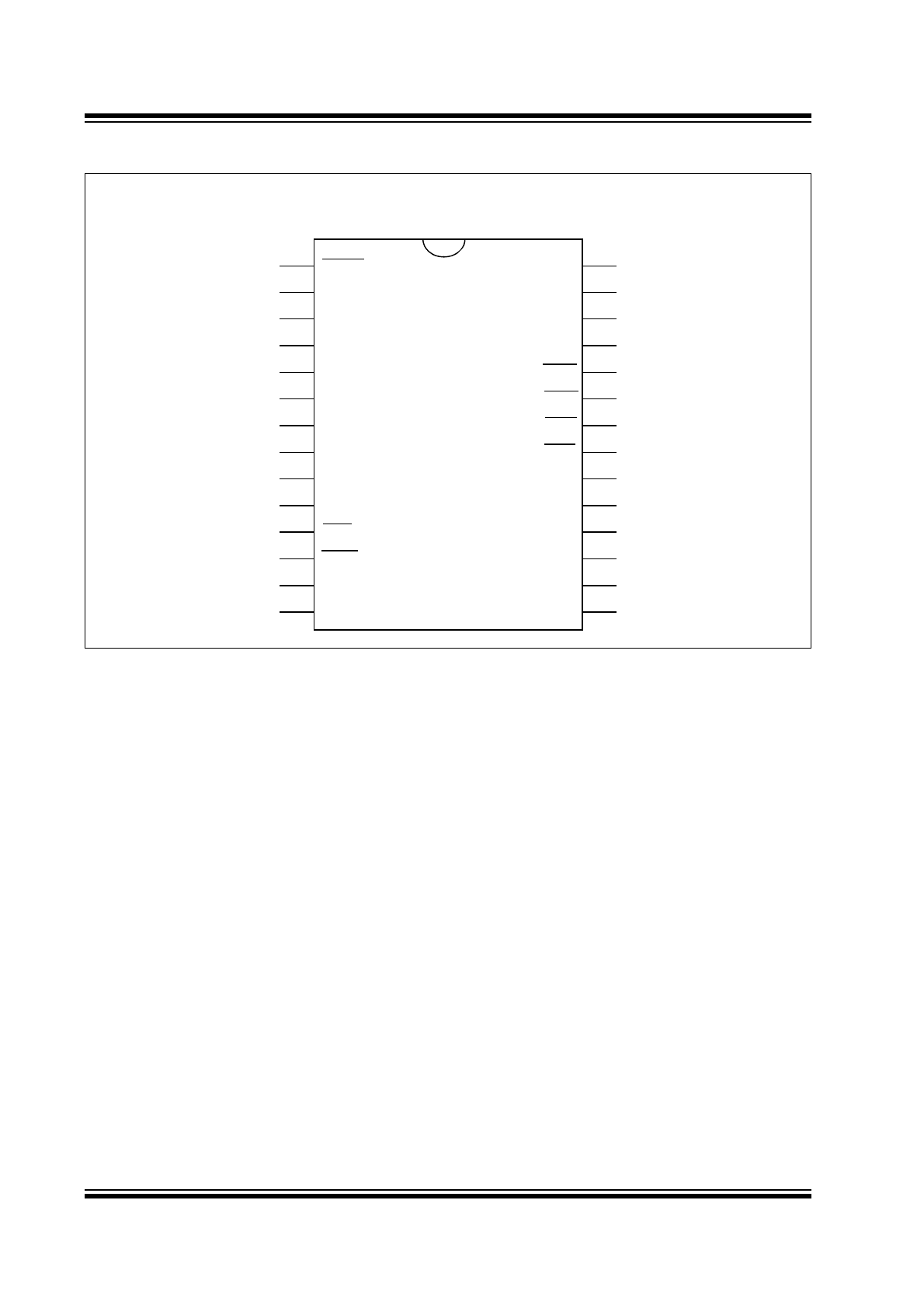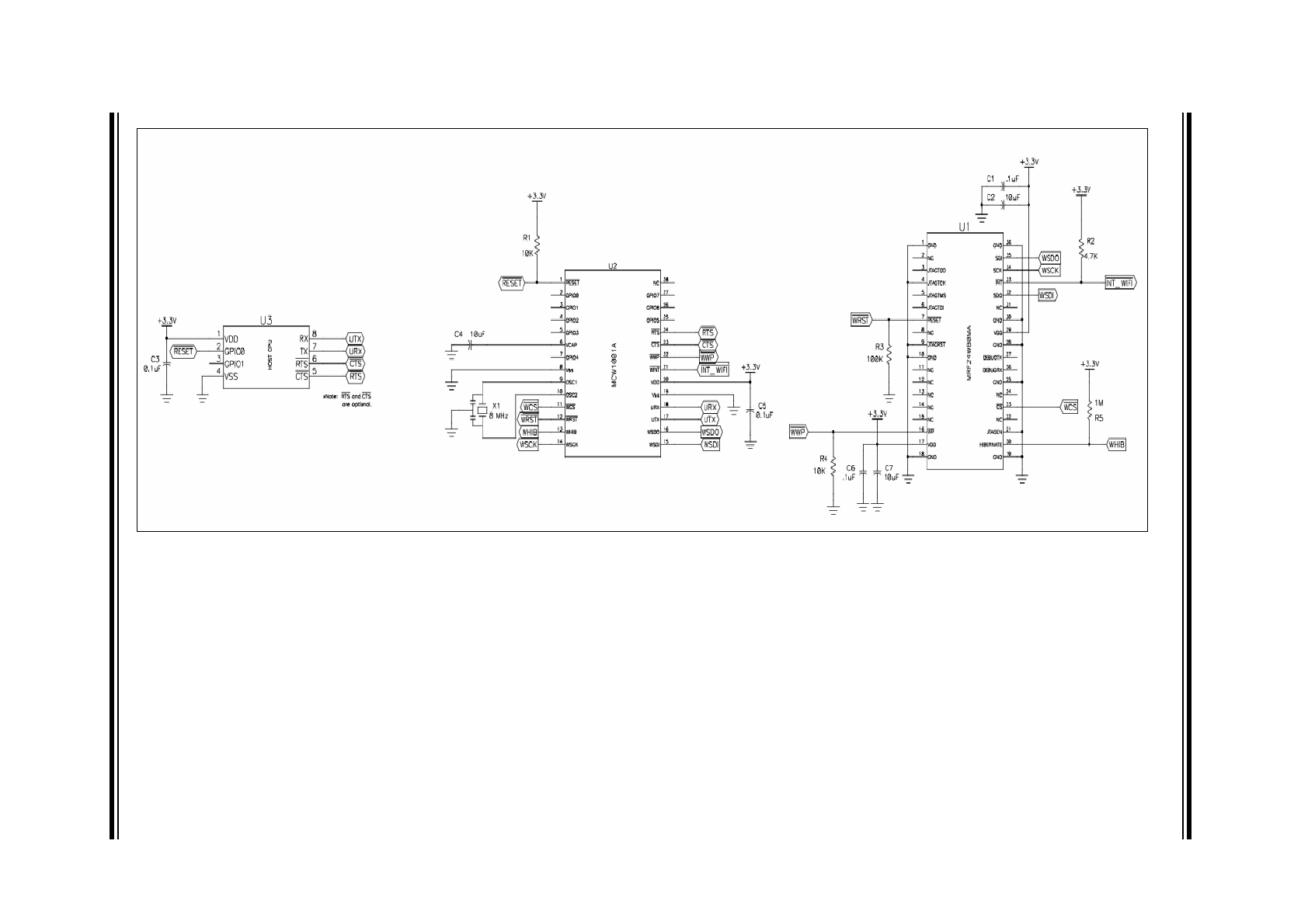
© 2011 Microchip Technology Inc.
Preliminary
DS70671A
MCW1001A
Data Sheet
TCP/IP Socket Communications
Interface with GPIO

DS70671A-page 2
Preliminary
© 2011 Microchip Technology Inc.
Information contained in this publication regarding device
applications and the like is provided only for your convenience
and may be superseded by updates. It is your responsibility to
ensure that your application meets with your specifications.
MICROCHIP MAKES NO REPRESENTATIONS OR
WARRANTIES OF ANY KIND WHETHER EXPRESS OR
IMPLIED, WRITTEN OR ORAL, STATUTORY OR
OTHERWISE, RELATED TO THE INFORMATION,
INCLUDING BUT NOT LIMITED TO ITS CONDITION,
QUALITY, PERFORMANCE, MERCHANTABILITY OR
FITNESS FOR PURPOSE. Microchip disclaims all liability
arising from this information and its use. Use of Microchip
devices in life support and/or safety applications is entirely at
the buyer’s risk, and the buyer agrees to defend, indemnify and
hold harmless Microchip from any and all damages, claims,
suits, or expenses resulting from such use. No licenses are
conveyed, implicitly or otherwise, under any Microchip
intellectual property rights.
Trademarks
The Microchip name and logo, the Microchip logo, dsPIC,
K
EE
L
OQ
, K
EE
L
OQ
logo, MPLAB, PIC, PICmicro, PICSTART,
PIC
32
logo, rfPIC and UNI/O are registered trademarks of
Microchip Technology Incorporated in the U.S.A. and other
countries.
FilterLab, Hampshire, HI-TECH C, Linear Active Thermistor,
MXDEV, MXLAB, SEEVAL and The Embedded Control
Solutions Company are registered trademarks of Microchip
Technology Incorporated in the U.S.A.
Analog-for-the-Digital Age, Application Maestro, chipKIT,
chipKIT logo, CodeGuard, dsPICDEM, dsPICDEM.net,
dsPICworks, dsSPEAK, ECAN, ECONOMONITOR,
FanSense, HI-TIDE, In-Circuit Serial Programming, ICSP,
Mindi, MiWi, MPASM, MPLAB Certified logo, MPLIB,
MPLINK, mTouch, Omniscient Code Generation, PICC,
PICC-18, PICDEM, PICDEM.net, PICkit, PICtail, REAL ICE,
rfLAB, Select Mode, Total Endurance, TSHARC,
UniWinDriver, WiperLock and ZENA are trademarks of
Microchip Technology Incorporated in the U.S.A. and other
countries.
SQTP is a service mark of Microchip Technology Incorporated
in the U.S.A.
All other trademarks mentioned herein are property of their
respective companies.
© 2011, Microchip Technology Incorporated, Printed in the
U.S.A., All Rights Reserved.
Printed on recycled paper.
ISBN: 978-1-61341-681-5
Note the following details of the code protection feature on Microchip devices:
•
Microchip products meet the specification contained in their particular Microchip Data Sheet.
•
Microchip believes that its family of products is one of the most secure families of its kind on the market today, when used in the
intended manner and under normal conditions.
•
There are dishonest and possibly illegal methods used to breach the code protection feature. All of these methods, to our
knowledge, require using the Microchip products in a manner outside the operating specifications contained in Microchip’s Data
Sheets. Most likely, the person doing so is engaged in theft of intellectual property.
•
Microchip is willing to work with the customer who is concerned about the integrity of their code.
•
Neither Microchip nor any other semiconductor manufacturer can guarantee the security of their code. Code protection does not
mean that we are guaranteeing the product as “unbreakable.”
Code protection is constantly evolving. We at Microchip are committed to continuously improving the code protection features of our
products. Attempts to break Microchip’s code protection feature may be a violation of the Digital Millennium Copyright Act. If such acts
allow unauthorized access to your software or other copyrighted work, you may have a right to sue for relief under that Act.
Microchip received ISO/TS-16949:2009 certification for its worldwide
headquarters, design and wafer fabrication facilities in Chandler and
Tempe, Arizona; Gresham, Oregon and design centers in California
and India. The Company’s quality system processes and procedures
are for its PIC
®
MCUs and dsPIC
®
DSCs, K
EE
L
OQ
®
code hopping
devices, Serial EEPROMs, microperipherals, nonvolatile memory and
analog products. In addition, Microchip’s quality system for the design
and manufacture of development systems is ISO 9001:2000 certified.

© 2011 Microchip Technology Inc.
Preliminary
DS70671A-page 3
MCW1001A
Key Features:
• Supports BSD like socket based connections
• Built-in Wi-Fi
®
connection management
messages
- Simplifies finding, connecting and
maintaining a Wi-Fi connection
• Easy-to-use messaging interface
• No external memory required
• Connects through Universal Asynchronous
Receiver/Transmitter (UART)
• Operates seamlessly with the MRF24WB0MA/MB
802.11 modules
• Easy integration into a final product
- Accelerates product development, provides
quicker time to market
• Designed for use with any microprocessor hosting
a UART port
• 8 general-purpose digital I/O
• Small size: 28 SSOP
Operational:
• Single operating voltage: 2.7V–3.6V(3.3V typical)
• Temperature range: -40°C to +85°C industrial
• UART interface, up to 230 Kbaud
• Low-current consumption:
- 10 mA operational current
Applications:
• Using MRF24WB0M module with standard UART
interface
• Using custom stacks with Microchip
microcontrollers
Markets:
• Utility and Smart Energy
- Thermostats
- Smart Meters
- White Goods
- HVAC
• Consumer Electronics
- Home security
• Industrial Controls
- Chemical sensors
- HVAC
- Security systems
- M2M communication
• Remote Device Management
- Automotive
- Code update
• Retail
- POS Terminals
• Medical, Fitness, and Health care
- Glucose meters
- Fitness equipment
- Patient asset tracking
TCP/IP Socket Communications Interface with GPIO

MCW1001A
DS70671A-page 4
Preliminary
© 2011 Microchip Technology Inc.
Pin Diagram
1
10
9
8
7
6
5
4
3
2
23
24
25
26
27
28
14
13
12
11
19
20
21
22
16
17
18
15
RESET
V
SS
V
DD
WINT
OSC2
OSC1
V
SS
NC
GPIO7
GPIO6
GPIO5
URTS
UCTS
WWP
GPIO4
VCAP
GPIO3
GPIO2
GPIO1
GPIO0
WSD0
UTX
URX
WSCK
WHIB
WRST
WCS
WSDI
MCW1001A
SSOP

© 2011 Microchip Technology Inc.
Preliminary
DS70671A-page 5
MCW1001A
Table of Contents
1.0
Device Overview .......................................................................................................................................................................... 7
2.0
External Connections ................................................................................................................................................................. 15
3.0
Universal Asynchronous Receiver (UART) ................................................................................................................................ 19
4.0
Network Configuration................................................................................................................................................................ 21
5.0
Transmitting And Receiving Packets.......................................................................................................................................... 23
6.0
Messaging API ........................................................................................................................................................................... 25
7.0
Electrical Characteristics ............................................................................................................................................................ 51
8.0
Packaging Information................................................................................................................................................................ 57
Appendix A: Revision history ............................................................................................................................................................... 61
The Microchip Web Site....................................................................................................................................................................... 63
Customer Change Notification Service ................................................................................................................................................ 63
Customer Support................................................................................................................................................................................ 63
Reader Response ................................................................................................................................................................................ 64
Product Identification System .............................................................................................................................................................. 65
TO OUR VALUED CUSTOMERS
It is our intention to provide our valued customers with the best documentation possible to ensure successful use of your Microchip
products. To this end, we will continue to improve our publications to better suit your needs. Our publications will be refined and
enhanced as new volumes and updates are introduced.
If you have any questions or comments regarding this publication, please contact the Marketing Communications Department
via E-mail at
docerrors@microchip.com
or fax the Reader Response Form in the back of this data sheet to (480) 792-4150.
We welcome your feedback.
Most Current Data Sheet
To obtain the most up-to-date version of this data sheet, please register at our Worldwide Web site at:
http://www.microchip.com
You can determine the version of a data sheet by examining its literature number found on the bottom outside corner of any page.
The last character of the literature number is the version number, (e.g., DS30000A is version A of document DS30000).
Errata
An errata sheet, describing minor operational differences from the data sheet and recommended workarounds, may exist for current
devices. As device/documentation issues become known to us, we will publish an errata sheet. The errata will specify the revision
of silicon and revision of document to which it applies.
To determine if an errata sheet exists for a particular device, please check with one of the following:
• Microchip’s Worldwide Web site;
http://www.microchip.com
• Your local Microchip sales office (see last page)
When contacting a sales office, please specify which device, revision of silicon and data sheet (include literature number) you are
using.
Customer Notification System
Register on our web site at
www.microchip.com
to receive the most current information on all of our products.

MCW1001A
DS70671A-page 6
Preliminary
© 2011 Microchip Technology Inc.
NOTES:

© 2011 Microchip Technology Inc.
Preliminary
DS70671A-page 7
MCW1001A
1.0
DEVICE OVERVIEW
The MCW1001A is a companion chip to the
MRF24WB0 802.11 module. It provides simple socket
based method of sending and receiving data from the
MRF24WB0 802.11 module. The MCW1001A has an
on-board TCP/IP stack and 802.11 connection
manager to simplify the connection between a wireless
network and the TCP/IP stack management. After the
initial configuration is set, the MCW1001A can access
the MRF24WB0 802.11 module to connect to a network
and send/receive serial data over a simple UART
interface.
Figure 1-1
illustrates a general block diagram of the
MCW1001A device.
Figure 1-2
illustrates application schematic.
Figure 1-3
illustrates application block diagram.
Table 1-1
lists the functions of the various pins shown
in the pin diagram.
Table 1-2
lists the UART API summary
FIGURE 1-1:
BLOCK DIAGRAM
UART
Controller
Baud
Generator
Control
Wi-Fi
TCP/IP Stack
MRF24WMB0
Driver
V
SS
Reset
Oscillator
Voltage
Regulator
GPIO1
UTX
URTS
URX
UCTS
GPI0 [0-7]
V
SS
V
DD
OSC2
OSC1
RESET
WWP
WCS
WSCK
WSDO
WSDI
WINT
WRST
WHIB
Manager
Connection

MCW1001A
DS70671A-page 8
Preliminary
© 2011 Microchip Technology Inc.
TABLE 1-1:
PINOUT DESCRIPTION
Pin
Number
Pin Name
Type
Description
1
RESET
I
Active-low Reset to the device.
2
GPIO0
I/O
General-purpose I/O
3
GPIO1
I/O
General-purpose I/O
4
GPIO2
I/O
General-purpose I/O
5
GPIO3
I/O
General-purpose I/O
6
VCAP
I
External filter capacitor connection for internal regulator
7
GPIO4
I/O
General-purpose I/O
8
V
SS
P
Ground
9
OSC1
I
Oscillator input
10
OSC2
O
Oscillator output
11
WCS
O
SPI Slave select output to MRF24WB0M
12
WRST
O
External Reset output control to MRF24WB0M
13
WHIB
O
HIBERNATE mode enable output to MRF24WB0M
14
WSCK
O
SPI clock output to MRF24WB0M
15
WSDI
I
SPI data input from MRF24WB0M
16
WSDO
O
SPI data output to MRF24WB0M
17
UTX
O
USART asynchronous transmit
18
URX
I
USART asynchronous receive
19
V
SS
P
Ground
20
V
DD
P
Power
21
WINT
I
External interrupt from MRF24WMB0
22
WWP
O
External write protect control to MRF24WB0M
23
UCTS
I
USART asynchronous clear to send (optional)
24
URTS
O
USART asynchronous request to send (optional)
25
GPIO5
I/O
General-purpose I/O
26
GPIO6
I/O
General-purpose I/O
27
GPIO7
I/O
General-purpose I/O
28
NC
NC
No Connect
Legend:
Pin type abbreviation: P = Power input I = Input
O = Output NC = No Connect
Note:
Signals of Type “I: Constant” must either be constantly driven by the host or have a pull-up or pull-down (in
case the host is likely to tri-state the signal during power down modes). The constant drive is used to ensure
defined operation of the part and to minimize leakage current during low-power operation.

©
2011
Microchip Technology Inc.
Prelimina
ry
DS70671A-
page
9
MCW1001A
FIGURE 1-2:
EXAMPLE APPLICATION SCHEMATIC

© 2011 Microchip Technology Inc.
Preliminary
DS70671A-page 10
MCW1001A
FIGURE 1-3:
APPLICATION BLOCK DIAGRAM
